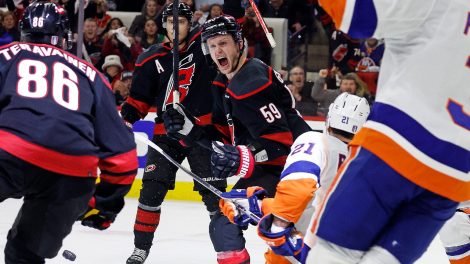Let’s talk about the NHL playoff picture.
For most hockey fans, the immediate reaction to that sentence is to look at a calendar and question the sanity of the person writing it. It’s early November, every team in the league is stuck between just 10 and 15 games played, and as we know, the NHL season goes on forever.
We should also know by now that in the modern NHL, parity rules the day.
Commissioner Gary Bettman, a bean-counter’s bean-counter, has long laboured to create such an environment. He appreciates the many marketing advantages of having lots of teams in the playoff race late, and of having teams capable of rising from the league floor to the middle of the pack in a single season.
“As long as the hockey is exciting and entertaining, that’s what it’s all about,” Bettman said at the 2016 Draft lottery. “And we have the most incredible competitive balance and you’re seeing it in terms of the number of teams that made the playoffs this year that didn’t the year before; I think that’s five teams, last year it was seven.”
[snippet ID=3322139]
Some of that balance is genuine and a direct result of equalizing forces like the salary cap and draft lottery. Much of it is artificial, thanks to measures which tend to bunch teams together, with three-point games, the shootout and a long trend towards lower-scoring games among them.
One side effect of that artificial equivalence is that it makes it really difficult to move rapidly up or down the standings over the course of a year.
Elliotte Friedman often mentions the Nov. 1 benchmark: Teams four points (or more) out of the playoffs at that point rarely overcome the deficit. Since 2005-06, 46 of 52 teams (88 per cent) that far out on Nov. 1 ended up missing the playoffs. Among Canadian teams this year, both Montreal (four points, since expanded to six) and Edmonton (seven points) meet that description.
It’s worth going into the math a little bit here.
Let’s imagine, for a moment, that we have a magic orb with one function: It can give us the true talent of an NHL team, with no allowance at all for luck, in terms of standings points. For the sake of argument, let’s further say that it tells us Edmonton and Montreal are 100-point teams on merit, which isn’t crazy given that both clubs were expected to be only a little worse than their matching 103-point finishes last year.
Given the infallibility of our orb, we can compare how well those teams should have done to how well they’ve actually done. We also know that the rest of the way those teams should play at a 100-point pace:
| How a 100-point talent team fares after a bad start | ||||
|---|---|---|---|---|
| Team | Talent | Expected at Nov. 1 | Actual at No.v 1 | Final pace |
| Edmonton | 100 | 13 | 7 | 94 |
| Montreal | 100 | 16 | 9 | 93 |
Already our 100-point teams are in some danger. The average wild card team over the past four years had 96 points; the average best team to miss the playoffs had 91. Four of those eight best-non-playoff teams finished with a point total of 93 or better.
Additionally, there’s an even chance of even more bad luck (poor health, unfortunate bounces, whatever). The dice have no memory, so more bad luck is exactly as likely as equalizing good fortune.
If our 100-point Edmonton or Montreal teams bleed just four more points that way over the last 70-ish games of the year, both become almost certain to miss the post-season. Only one sub-90-point team has made the playoffs in the past four seasons.
[snippet id=3638287]
That’s a little unsettling if you’re rooting for either of those teams, but the reality is actually worse because our Orb of NHL Standings Truth is an imaginary construct which existed solely for the purposes of the last few paragraphs. Despite fairly successful recent histories, we don’t know that the Oilers or Canadiens are really true-talent 100-point teams. They might be better than that, but with every passing loss it becomes more likely that their actual level of ability is somewhat lower.
Because of the league’s overwhelming parity, it doesn’t take much of an adjustment for the situation to get really bleak. If the first month of the season convinces us to adjust the expectations of those teams downward just four points, from 100 to 96, again we find the playoffs have become a long shot even with average fortune the rest of the way.
| How a 96-point talent team fares after a bad start | ||||
|---|---|---|---|---|
| Team | Talent | Expected at Nov. 1 | Actual at Nov. 1 | Final pace |
| Edmonton | 96 | 13 | 7 | 90 |
| Montreal | 96 | 15 | 9 | 90 |
That’s not to say a team in this position should give up and write off the rest of the season. A lot of those failed teams knew they were going to be bad before the season started. Some of the greatest stories in sports are improbable comebacks, and a club that started the season with a reasonable expectation of success has little choice but to maintain the courage of its convictions.
But the unlikely recoveries from terrible starts are great stories precisely because they’re so rare. Recent history shows that nine out of 10 teams in a deep hole at the start of November will be golfing come April. For all the calm reassurances going around right now that the season is still young, the truth is that it doesn’t have to get very old before we can start penciling in the also-rans.
[relatedlinks]









